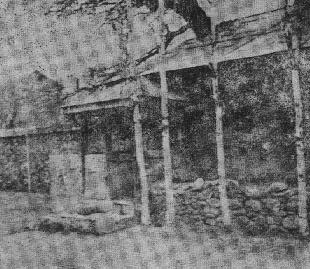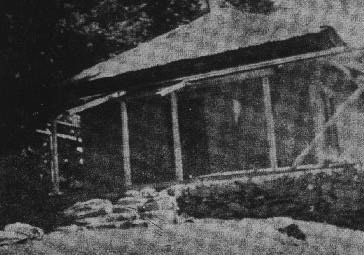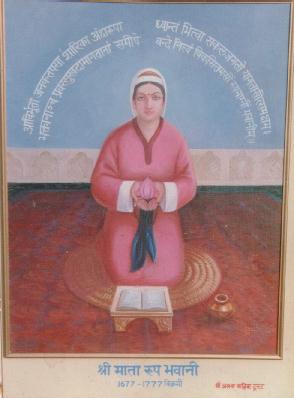The Life of
Devi Roop Bhawani
by Aparna Dar
[ This is an account
of the life of Devi Roop Bhawani who was born in
Srinagar on Jyaistha Paurnamasi, AD 1621. She was
a fully illumined soul who because of her divine
nature was said to have been born of the elements
of Divine Mother. The author of thc article is a
lecturer at the Indian Institute of Technology,
Kanpur]
In
the early seventeenth century, a Kashmiri Pundit
named Madhav Joo Dhar lived in Srinagar. Madhav
Joo was of a deeply religious and philosophical
temperament, and his daily life was conducted in
an impeccably religious spirit. He worshipped the
Supreme Being (Ishwara) in the form of the Divine
Mother Sharika (Durga).
In Srinagar, there is a
hill known as Hara Parvat or Sharika Parvat where
the Goddess Sharika is worshipped since ancient
times. Legend relates that, long ago, some demons
troubled the local people, who prayed to Goddess
Durga for protection. She took the form of a
Sharika (Maina) bird and dropped a large chunk of
earth on the entrance to the cave of the demons to
seal them inside the hill. She then took Her abode
on the hill to ensure that they did not escape.
This gave the name Sharika Parvat to the hill. The
Goddess is represented there by the Sri Chakra (a
regular geometrical mystical pattern) in sandy
rock, which is annointed with red lead (sindur).
The deity is also called Chakreshwari. Regular
worship has been offered at this shrine for
centuries.
To this shrine of the
Divine Mother Sharika, Madhav Joo came every day
to worship in the auspicious hour of Brahma
Muhurta (pre-dawn). He would chant Her Holy Name,
with his face glowing with devotion and his entire
being absorbed in Her worship. For hours he would
be so transported, the fire of devotion lighting
up his entire being with Divine radiance. Thus did
this devotee of the Divine Mother pass his days.
It is said that on the
first day of the Navaratri (the nine days
dedicated to the worship of the Divine Mother
Durga) in the month of Ashwin, in the year 1620,
Madhav Joo arrived for worship at midnight, to
uninterruptedly worship on this most auspicious
occasion.
He commenced his worship
and, with all reverence and attentive detail, he
glorified the Supreme Goddess, his heart filled
with adoration. When his worship was complete, the
Divine Mother is said to have appeared before him
in the form of a radiant girl child.
On seeing this divine
child, Madhav was so filled with intense joy and
bliss that he lost all consciousness of his
external surroundings, and tears of joy and
devotion flowed from his eyes. He understood that
the mother of the Universe, Mahamaya, was Herself
in front of him in the form of this child.
Thereupon he worshipped
the girl, placing flowers at Her feet and incense
before Her. With fatherly love he offered Her
sweets. The Mother was pleased with the simplicity
and love of Her devotee, and granted him a boon.
Madhav requested Mother, 'Since you have appeared
before me in the form of a child, take birth in my
house as my daughter.' The Divine Mother granted
the boon and vanished. So goes the legend of the
birth of Roopa Bhavani.
In the following year
1621, in the month of Jyeshtha, on the Poornima
Tithi (full moon), in the early morning a daughter
was born to Madhav Joo's wife. He named his
daughter Alakshyeshvari, which means one who is
imperceptible and indescribable; it refers to the
Goddess in the formless non-dual aspect.
In her father's house,
Alakshyeshvari's years of childhood were passed in
the company of devotees. Madhav Joo was held in
high esteem, and spiritual seekers came from
far-away provinces to meet him. Alakshyeshvari's
spirituality blossomed early in these favourable
conditions. As she grew older, the spiritual
tendencies within her became increasingly
manifest. Her father, Madhav Joo, himself became
her guru and gave her spiritual initiation.
Nevertheless, in accordance with the prevailing
customs of the time, her father arranged her
marriage to a young man of the nearby Sapru
family.
However, Alakshyeshvari's
married life was unhappy. Her husband, Hiranand
Sapru, totally lacked all understanding of
Alakshyeshvari's spiritual nature; and her
mother-in-law, Somp Kunj, had a cruel disposition.
Alakshyeshvari's life in this house was difficult
and joyless. Her mother-in-law was always finding
fault with her. Once she accused Alakshyeshvari of
going out at midnight, and made Hiranand
suspicious of his wife's fidelity.
The truth was that at
midnight Alakshyeshvari would go to perform her
sadhana (spiritual practice) at the shrine of
Mother Sharika on Hara Parvat. One day Hiranand
followed her to see where she went at night.
Alakshyeshvari knew this. When she had nearly
reached the shrine, she turned around and asked
Hiranand lo join her. However, as he was steeped
in ignorance, he is said to have beheld a vast
expanse of water, impossible to cross, between
himself and her and, disheartened, he was forced
to return home.
Yet another incident is
related of her life in her in-laws' home. One day,
on the occasion of some festival, Madhav sent his
daughter a pot of rice pudding (kheer).
Alakshyeshvari's mother-in-law, on seeing the
kheer spoke sarcastically, 'What will I do with
this small pot of kheer? I have so many relatives;
this is hardly sufficient for them.'
Alakshyeshvari replied, 'Please give this kheer to
as many persons as you like, but don't look inside
the pot.' Somp Kunj began to ladle out the kheer
and gave it to everyone she knew. But the supply
of kheer seemed endless! Finally, furious with
anger, Somp Kunj looked inside the pot to find
just a few grains sticking to its sides.
The next day at dawn,
Alakshyeshvari cleaned the pot, and placed it in
the flowing current of the Vitasta river, speaking
thus, 'My father is doing his morning prayers (Sandhya)
at the Diddmar Ghat. Go and stop there.' The pot
floated down the Vitasta river and stopped exactly
where Madhav Joo was doing his Sandhya. Madhav
picked up the pot and took it home.
Even after seeing such
miraculous incidents, not just once, but many
times, Somp Kunj stubbornly refused to change her
ways towards Alakshyeshvari. Hiranand also
remained foolish and ignorant. Finally, when
living there became unbearable, Alakshyeshvari
left her husband's house never to return. It is
said that this Sapru family's fortunes rapidly
declined therafter.

The birth-place of Devi
Roop Bhawani Navakadal, Srinagar.
Alakshyeshvari renounced
her father's home as well, and decided to seek the
eternal abode of the Supreme Being. She wanted to
become absorbed in sadhana. Seeking a solitary
retreat, she selected a location to the north-east
of Srinagar, known by its ancient name Jyestha
Rudra. Here she did intense tapasya (austerities)
for twelve and a half years, and began to glow
with the fire of spirituality. At this point,
people, attracted by her spiritual radiance, began
to come to her in such large numbers that she
decided to leave the place for a more solitary
retreat.
She moved to a village
Mani Gaon, in north Kashmir, on the banks of the
Ganges in the foothills of the Himalayas. On
festival days many people would gather at Mani
Gaon for a dip in the sacred waters. In these
beautiful surroundings Alakshyeshvari chose to do
her sadhana. On a forested hill-top, far from the
village, she made a hermitage for herself. For a
long time she remained in solitude, deep in
spiritual practices.
It is said that none of
the villagers at Mani Gaon knew of
Alakshyeshvari's existence, until a certain
miraculous incident revealed her presence to them.
A cowherd boy used to take his cows to graze at a
place which, unknown to him, was close to where
Alakshyeshvari was absorbed in meditation. The boy
noticed that a beautiful white cow left the herd
every day at noon, and later returned on her own
accord. One day he decided to follow the cow to
see where she went.
Following the cow, he
reached a clearing in the forest. There he saw a
beautiful woman dressed in ochre robes seated in
meditation, her long hair flowing loosely, her
face ashine with a heavenly lustre, and her eyes
filled with a divine light. The cow, as though
under a spell, stopped before the radiant ascetic.
The ascetic woman got up and lovingly caressed the
cow. The cow of her own accord poured its milk
into the ascetic's bowl until it was full!
On seeing this wonderful
vision the cowherd boy lost consciousness. When he
milked the white cow he found to his astonishment
that she gave even more milk than usual.
The cowherd confided his
experiences to Lal Chandra, the village head. Lal
was filled with reverence and devotion. He visited
Alakshyeshvari, and then came daily to serve her
in whichever way he could. By this time she had
completed another twelve and a half years of
spiritual practice in that hermitage.
We will from here refer
to her as Bhavani (the Goddess as the power
originating the world) or as Bhagavati (the
Goddess with the six attributes of supremacy,
righteousness, fame, prosperity, wisdom, and
discrimination). This is in keeping with the
common belief in Kashmir that Alakshyeshvari was
an incarnation of the Goddess Durga.
Lal Chandra told the
villagers about Bhavani and the miraculous
happenings attributed to her. But when she began
to receive a great deal of public attention, she
left the village, preferring to continue her
spiritual practices in solitude. She went to dwell
in a hut on the bank of the Shahkol river. Even
there she attracted devotees.
Once, a spiritual seeker
fascinated by her aura of spirituality asked her,
'What is your name?' Bhavani replied, 'My name is
Roopa (one who has realized her own True Self).'
The seeker further questioned her, 'Why do you
wear this ochre dress?' Bhagavati replied, 'This
ochre represents the state of being in which the
individual soul has taken the colour of the
Supreme Being.'
Bhavani lived for many
years on the banks of the Shahkol, absorbed in
meditation. Finally, when large numbers of
devotees again began to flock around her, she once
more moved away to a quieter spot, in the village
of Vaskora. Legend says that the Naga, (snake)
Vasuki, did his tapasya in Vaskora to attain the
Grace of Shiva. When his sadhna bore fruit, he
asked Lord Shiva for a boon, 'May I always adorn
you as a necklace. ' Bhagavati greatly liked this
spot and began to dwell there.
Bhavani's grace now began
to shower on her numerous devotees. Many miracles
are attributed to her. There was a young boy,
blind from birth, who served her with great
devotion. Bhavani's compassionate heart was moved
by his sad condition. Shc gave him a stick and
asked him to dig the earth with it. He immediately
obeyed her. Many devotees gathered nearby,
watching. Soon water began to appear from the hole
that was dug. Bhavani said to the young boy, 'Wash
your eyes with the water that has come forth.' As
the boy did so, his sight was restored and the
crowd of devotees were amazed.
Bhavani had a brother,
Lal Joo, who was very devoted to her and took her
as his guru. Lal's son, Bal, began to stay with
her in her service. Once, Lal requested Bhavani to
educate his illiterate son. Bhavani gave the boy a
pen and some paper and ordered him to write.
Thereupon, miraculously, the boy began to write
fluently like a highly educated person. The
devotees were overwhelmed by this transformation.

The room in the village
of Lar in which she performed her sadhana.
In Vaskora, Bhavani began
to give spiritual instruction to Bal Joo Dar and
Sadanand Muttoo in the form of poetical verses,
called Vakhs. One hundred and forty-five of her
Vakhs have been transmitted to us. After twelve
and a half years (periods of this length seem to
recur in Bhavani's life) had elapsed in Vaskora,
Bhavani returned to Srinagar on the entreaties of
her numerous devotees, and began to live in
Saphakadal.
Many years had elapsed,
and Bhavani now yearned to be released from her
earthly body. On the Saptami Tithi, in the month
of Magha, in the year 1721, Bhavani's soul took
flight forever. The legend relates how her
devotees, filled with grief, carried her body
towards the cremation ground. On the way they met
the village head who, on seeing the funeral
procession, asked whom they were carrying. On
hearing that it was Roop Bhavani, he was very
startled, for he had just seen Bhavani walking
down the road by which he came! The devotees
looked inside the coffin and found nothing there
but some alak (locks-of hair) and some flowers.
The alak are even today worshipped with great
reverence.
Although she is not with
us now, Roopa Bhavani's Vakhs ate so vibrant with
her presence that on reading them one feels that
she is very near, giving knowledge to her children
with powerful words of renunciation, and
dispelling ignorance with the weapon of Eternal
Truth. May she guide us on the true path of
knowledge, towards the Divine Light.
(Courtesy: Prabuddha Bharata)
The author writes: The
first volume in English on Divine Mother Roop
Bhavani was Sri Trilokinath Dhar's pioneering work
(Rupa Bhawani - Life, Teachings and Philosophy)
published in 1977 by All India Saraswat Cultural
Organization, Srinagar. However the present author
has obtained the Vakha of Devi Roop Bhavani and
her life history from Sri Roop Bhavani Rahasya
Upadesa (1977) published in Hindi by Sri Alakh
Sahiba Trust, Srinagar. Further, she has gained an
insight into the legends relating to Sharika
Bhagavatiand Her Peetha at Hari Parvat from
Bhavani Nama Sahasra Stutih by Sri Jankinath Kaul
'Kamal' published from Ramakrishna Ashram,
Srinagar.
Source: Koshur
Samachar
| 















No one has commented yet. Be the first!